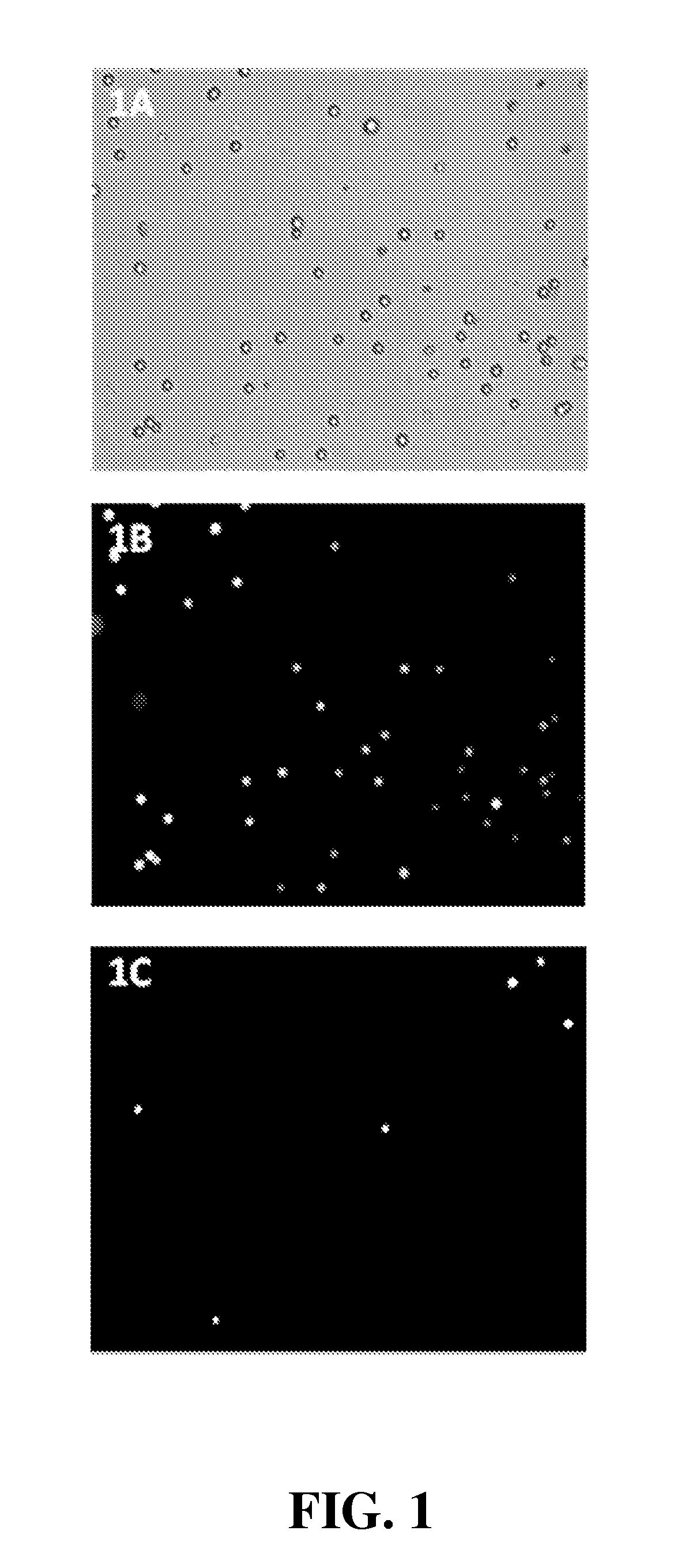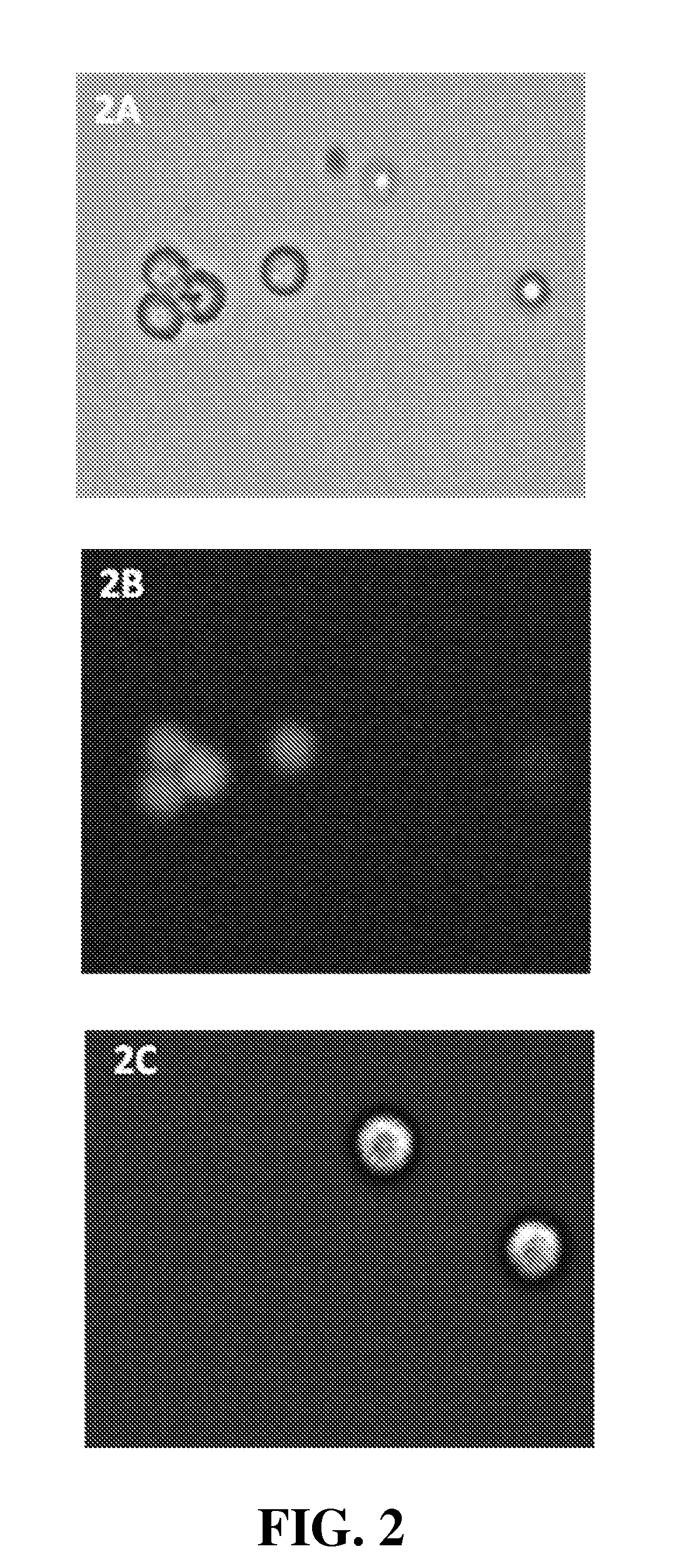Method and kit for assessing viable cells
a cell and kit technology, applied in the field of cell analysis methods and procedures, can solve the problems of extended incubation time, time-consuming, complex methods presently employed,
- Summary
- Abstract
- Description
- Claims
- Application Information
AI Technical Summary
Benefits of technology
Problems solved by technology
Method used
Image
Examples
example 1
[0150]Use of NAM to determine viability of proliferating Jurkat (JM) cells (a T lymphocyte cell line)
[0151]Materials and Methods. Jurkat (JM) cells were grown at 37° C. in a humidified air atmosphere with 5% CO2 in RPMI (Invitrogen, #61870) supplemented with 10% heat-inactivated fetal bovine serum (Invitrogen, #10108-165). 90 μL proliferating Jurkat cells (cell density 1.2×106, 99% viable determined using the NC-100 NucleoCounter system following the manufacturer's (ChemoMetec A / S) protocol) were added 10 μL NAM (N-(9-acridinyl)maleimide, Sigma, #01665, CAS no. 49759-20-8) dissolved in DMSO (100 μg NAM pr. mL DMSO) and mixed by pipetting. Cells were loaded into a NucleoCassette, containing the DNA stain propidium iodide (PI). The cells were investigated using an Olympus IX50 fluorescence microscope, and images were captured using a Lumenera CCD camera and in-house developed software. PI and NAM fluorescence were detected using, respectively, U-MWG2 (green long pass: 510-550 nm) and ...
example 2
[0153]Use of NAM to determine viability of HEK293 cells (a Human Embryonic Kidney cell line)
[0154]Materials and Methods. HEK293 cells were grown at 37° C. in a humidified air atmosphere with 5% CO2 in DMEM (Invitrogen, #31966) supplemented with 10% heat-inactivated fetal bovine serum (Invitrogen, #10108-165). Cells were harvested with 0.5 mL of trypsin (Invitrogen, #25300) and neutralized with 5 mL medium (DMEM+10% FCS) two days after they had reached full confluency. These outgrown HEK293 cells (cell density 1.6×106, 78% viable determined using the NC-100 NucleoCounter system following the manufacturer's (ChemoMetec) protocol) were stained with 10 μg / mL NAM (Sigma, #01665). Another cell sample were treated with 0.25% Triton X-100 (Sigma, #T9284) and hereafter added 10 μg / mL NAM. After staining, each cell sample was loaded into a NucleoCassette, containing the DNA stain propidium iodide (PI). The cells were investigated using an Olympus IX50 fluorescence microscope, and images were ...
example 3
[0156]Use of NAM to determine viability of Drosophila S2 cells
[0157](Drosophila melanogaster Schneider line-2 (S2) cells were originally derived from late embryonic stage Drosophila embryos.)
[0158]Materials and Methods. Drosophila S2 cells were grown at 28° C. without shaking in Schneider's Drosophila medium (Invitrogen, #21720) supplemented with 10% heat-inactivated fetal bovine serum (Invitrogen, #10108-165). S2 cells (cell density 1.7×107, 99% viable determined using the YC-100 NucleoCounter system with diploid settings following the manufacturer's (ChemoMetec) protocol) were diluted 10 times in PBS and stained with 10 μg / mL NAM (Sigma, #01665). Cells were loaded into a NucleoCassette, containing the DNA stain propidium iodide (PI). The cells were investigated using an Olympus IX50 fluorescence microscope, and images were captured using a Lumenera CCD camera and in-house developed software. PI and NAM fluorescence were detected using, respectively, U-MWG2 (green long pass: 510-55...
PUM
 Login to View More
Login to View More Abstract
Description
Claims
Application Information
 Login to View More
Login to View More - R&D
- Intellectual Property
- Life Sciences
- Materials
- Tech Scout
- Unparalleled Data Quality
- Higher Quality Content
- 60% Fewer Hallucinations
Browse by: Latest US Patents, China's latest patents, Technical Efficacy Thesaurus, Application Domain, Technology Topic, Popular Technical Reports.
© 2025 PatSnap. All rights reserved.Legal|Privacy policy|Modern Slavery Act Transparency Statement|Sitemap|About US| Contact US: help@patsnap.com



